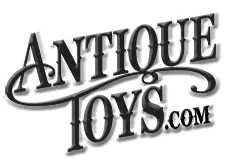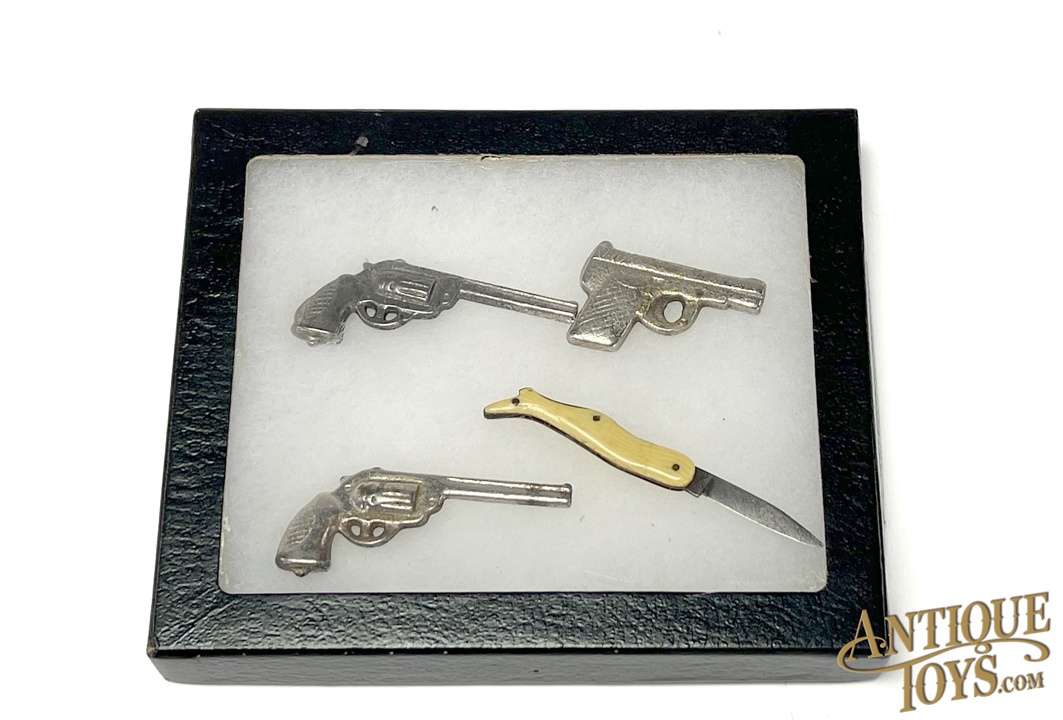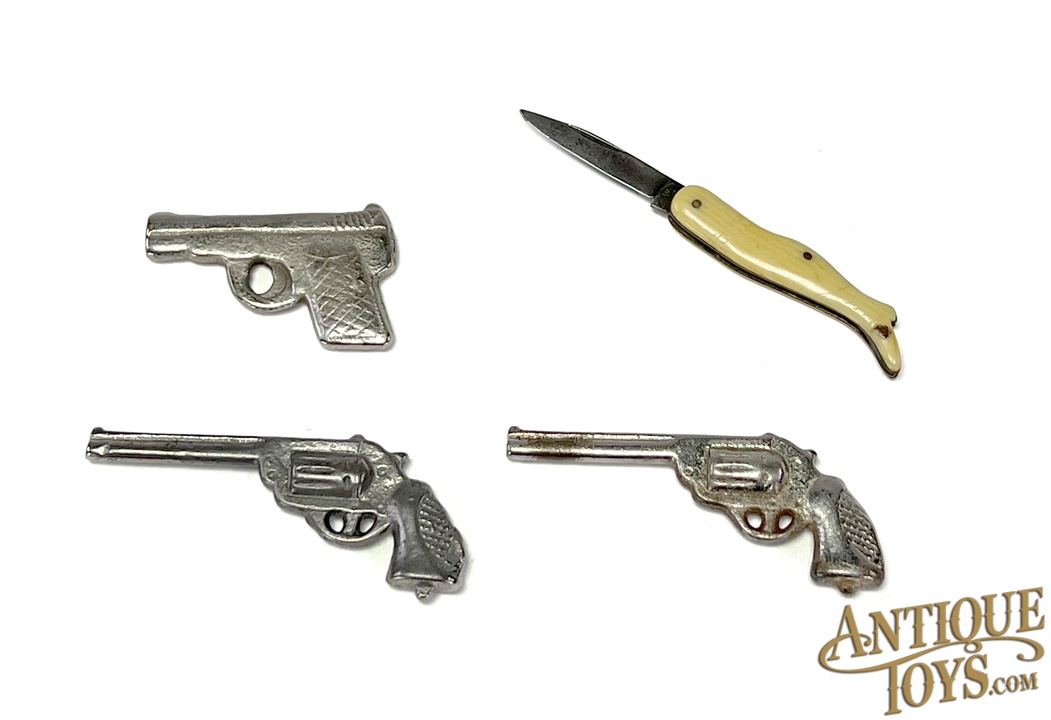Arcade Miniature Guns & Miniature Faux Ivory Pocket Knife in Riker Box for Sale
$55.00
Arcade Miniature Guns & Miniature Faux Ivory Pocket Knife in Riker Box
This is a grouping of 4 miniature weapons in a Riker display box the three guns were manufactured by the Arcade Manufacturing Company of Freeport, Illinois and the miniature pocket knife is by an unknown maker.
These pieces are original, with no breaks, restorations, repairs, or touch-ups. These pieces show the usual patina, fading, dust, chips, scuffs, surface rust, scratches, and wear that are to be expected from age and play and are sold as is. The Riker box is approximately 6” L x 5” W and each weapon is under 3” L except for the pocket knife once it’s folded out. We invite you to view the photos to further determine the quality and condition.
A history of the Arcade Manufacturing Company of Freeport, Illinois:
1885 – 1941
Founder: Al Baumgarten, Cyrus Tobias, Edward H. Morgan, and Charles Morgan
Specialty: The Arcade Manufacturing Company of Freeport, Illinois was originally founded as Novelty Iron Works by Edward H. and Charles Morgan in 1875, and conducted business in two small buildings with a staff of ten people. They manufactured cast iron products including pumps, windmills, iron pavements, storefronts, and agricultural products such as feed grinders. By 1884, Novelty Iron Works was no longer in business and the New Union Manufacturing Company was founded this same year by E.H. Morgan, Charles Morgan, and Cyrus Tobias. The company exclusively manufactures coffee and spice mills.
On October 20, 1885, the Arcade Manufacturing Company was incorporated by Al Baumgarten, Cyrus Tobias, Edward H. Morgan, and Charles Morgan. Sometime between 1885 and 1890, the company produced its first toy, a miniature box coffee mill. Between 1885 and 1893 the location of the Arcade factory moved around to several Freeport locations. In February of 1893, Arcade officials built a large factory at the new location and would remain there until the plant ceased production of all products in the 1950s.
Arcade toy catalogs appear to start in 1902 and as late as 1939. Arcade`s toy line included over 300 toy items. In 1900, the company initiated the production of stamped steel items for dolls, including buggies, cradles, beds, and swings. Additionally, they introduced a line of cast iron banks. As time progressed, the company expanded its toy offerings to include several horse-drawn toys. They also manufactured various other early toys such as pile drivers, railroad wrecking cars, lawnmowers, miniature cook stoves, sad irons, wheelbarrows, windmills, pumps, floor drains, and jackstones.
In 1919, toys constituted a small portion of Arcade’s overall business. At that point in time, toys constituted a mere 5% of Arcade’s overall product line, reflecting the company’s diverse range of offerings. The company came up with the concept of producing “novelty items” inspired by their own products and logos. Around 1920, they released their first promotional toys, which included the Red Goose Bank (associated with Red Goose Shoes), a miniature Avery tractor, and the Buster Brown Jack Set (related to another children’s shoe company).
In 1921, Isaac P. Gassman, the secretary and sales manager of Arcade, embarked on a trip to Chicago to visit a friend who had previously lived in Freeport, Illinois and now held the position of president at the Yellow Cab Company. During their meeting, an intriguing idea emerged between the two men. They reached an agreement that Arcade would undertake the production of a scaled-down replica of the famous Yellow Cab. The licensing agreement with the Yellow Cab Company, allowed them to manufacture and sell a realistic toy version of the Yellow Cab. This toy became a game-changer for the company, leading them to shift their primary focus to toy production. Company executives took a risk by deciding to produce high-quality, albeit more expensive, toys that were exact replicas of the real vehicles. They were initially concerned that the public might not be willing to spend more on toys no matter how high-quality they may be. However, their gamble paid off as they created a market by offering toys that truly appealed to children. The demand for their toys soared, and they quickly expanded their product line to include other replicas such as the Fordson Tractor, Andy Gump Car, Chester Gump in His Pony Cart, Oliver Plow, W. & K. Truck Trailer, and International Harvester Trucks. Arcade maintained a steadfast commitment to quality and authenticity, never compromising on these aspects. Each new toy’s pattern (mold) was meticulously crafted without sparing any expense. During this period, the company adopted the slogan “They Look Real.” By 1926, the revenue generated by Arcade’s cast iron toy division had nearly matched that of all other products, resulting in almost a million dollars in toy sales.
In 1928, Arcade introduced a captivating storybook for children called the “Tiny Arcadians.” This enchanting tale revolves around a group of fairy folk who embark on a mission to create toys for underprivileged children. The toys crafted by the Arcadians are not only visually appealing but also durable, ensuring the children’s happiness. The company generously distributed the storybook free of charge to anyone who requested it, spreading joy and imagination.
The year 1929 witnessed Arcade’s introduction of a toy inspired by the steamboat featured in the film “Showboat.” This particular toy boat, along with a steamboat bank, constituted the only two boat toys ever produced by Arcade. Additionally, the company delighted children with a deluxe ten-foot dollhouse that boasted electric lights, providing an extra touch of realism and excitement.
In 1933, Arcade’s creative prowess was evident as they designed a collection of toys specifically for the 1933 Century of Progress World’s Fair held in Chicago. This lineup included various sizes of buses known as “people-movers,” taxis, and Railplane cars, all adorned with the emblem “Century of Progress, Chicago, 1933” on their roofs. These toys captured the spirit of the fair and showcased Arcade’s dedication to innovation.
Arcade’s reputation soared in 1935 when they received a special order from the Canadian Greyhound Lines who commissioned Arcade to create five toy greyhound buses, one named for each of the renowned Dionne Quintuplet children of Canada; Yvonne, Annette, Cécile, Émilie, and Marie. Each bus featured the respective sister’s name meticulously stenciled on the roof, making these pieces truly unique and perhaps the most coveted items ever produced by Arcade.
In 1941, Arcade experienced a significant shift in its manufacturing endeavors. Due to the outbreak of World War II, the company made the noble decision to cease production of cast iron toys. Their resources were redirected towards supporting the war effort. Following the war, the toy manufacturing landscape underwent transformations as aluminum and plastics emerged as preferred materials for production. Consequently, Arcade never resumed toy manufacturing activities.
In 1947, Isaac P. Gassman, an executive at Arcade, generously donated the company’s collection of toys to the Stephenson County Historical Society. This substantial donation, consisting of various toys, found a permanent home and has been on public display ever since. Over time, the collection has expanded to include more than 800 toy examples, creating a captivating and cherished exhibit at the museum.
1 in stock
Additional information
| Weight | 2 lbs |
|---|---|
| Dimensions | 12 × 9 × 9 in |


